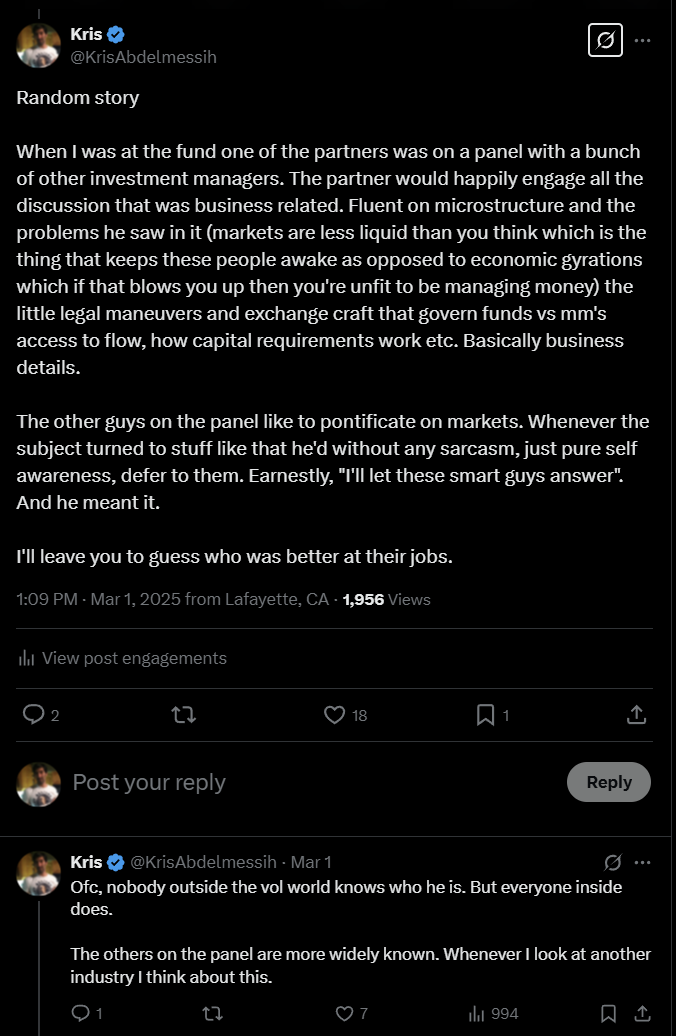surfing volatility
pure vol trading
Friday’s IBIT options expiration played out about as well as I could have hoped.
[I discussed my trades in videos here and here and here.]
Near Friday’s close, I sold my April 38 puts, closing out a trade where I benefitted from both implied volatility (IV) and skew dynamics.
When I entered the trade, it was a ratio calendar where I sold elevated near-term vol to buy 2x 6-week teeny puts.
Specifically:
On March 4th, I initially paid 61 vol for the April 38 puts and sold them at 63 at the Mar14 expiry, while the Mar14 48 puts I had sold at 64.5 vol saw their IV get crushed as they pinned near my short strike. The stock was $48.50 when I put the trades on and was trading $48.14 at expiry.
The ratio trade collected $0.65 on the small leg upfront, the fronts expired worthless and then I closed out the larger short leg at $0.40 per contract, yielding a total profit of $1.45. When I break down the attribution, I see a small win on IV (although the vega isn’t as meaningful as the gamma/theta battle on options of these tenor), a giant win on realized, a small loss on delta, and then the positive luck on path which is the short expiring at the strike. (I know, broken record, but: Short where she lands, long where she ain’t.)
[On Thursday I’ll publish the actual attribution. It contains a big lesson].
I want to zoom in on the experience broadly because it’s a classic experience of what vol trading looks like.
Surfing Volatility
Here's a breakdown of the past 10 days of positioning:
- Initial Trade Setup: I liked selling near-dated IBIT vol while buying extra teeny options in the second month for a calendar spread. I structured the trade with a delta bias so that if I was wrong on direction, my risk was tolerable, and I wouldn’t need to hedge aggressively.
- Volatility Spike & Adjustments: A few days later, IBIT fell, and vol spiked even further. Since I had extra “units” from my ratio structure, I took advantage by selling additional front-month options into the vol pop, which still seemed rich.
- Reversal & Volatility Decline: As IBIT recovered from the lows, IV dropped, and I naturally got shorter vol as it rallied away from my longs (April puts).
- Buying Vol on the Dip: Mid-week, I bought more options (August teeny puts) because vol had declined, and relative to the broader vol landscape (the moontower “blob”), IBIT was now looking cheap.
- Capitalizing on Vol Compression: Those fresh vol buys turned out to be the best-performing IVs on the board today, as vols continued to drop. Now, with vol even cheaper, I have the opportunity to roll my April and August teeny puts into straddles on a premium-neutral basis—for example, selling 8 units to buy 1 straddle (2 units). For now, I sold my long April teeny puts near the close as my March shorts expire or “go away” but still have my Auggies.

The screenshot highlights the options I own...the IV performed relatively well as vol comes in overall on the rally. The puts benefit from 2 forces:
- a rolling up the skew as they become further OTM
- the moneyness itself getting further away becomes vol is declining. It’s obvious that a fixed strike is a further percentage away as the stock rallies but the subtle effect is declining implied ATM vol means it’s yet even further away in standard deviation terms pushing it to an even steeper point in the skew.
The wave never ends
You ride and ride. The beach never comes.
Looking ahead to next week, if vol continues to come in, I’ll roll my deferred puts up, especially if BTC vols cheapen relative to the broader vol landscape. But really, this is just about having a game plan for everything—something is always relatively high or low, and you just react to what the market gives you.
A common mistake is focusing too much on whether an option will ever “get there.” The reality? Those deep OTM options that seem like obvious sales are always absolutely expensive. But that doesn’t matter. They’re almost like options on options—ammo. The owning the extra wings in this case allowed me to sell more weekly March options when they popped again because I owned what I like to call “the trap door”. My risk was capped. It’s always easy to dismiss OTM options as expensive because the mind says “that’ll never happen”. But that ignores the path of how market expectations and vols change as the underlying moves.
If the options I’m long never get there, that’s fine. Because the game isn’t about binary outcomes; it’s about surfing volatility.
If you fixate on “I can’t buy that option because it’ll never get there,” you’re trapped in directional mode. The real game is 3D vol thinking.
[If you don’t want to think dynamically about path and stay directional, vertical spreads are safest.]
Personal bit of commentary about the art of vol trading. Open to discussion on this because I’m curious how other option traders think:
“Surfing volatility” is the best way I can convey how I see vol trading. It feels closest to the essence. I guess I came into this paradigm because I never bothered to learn much about fundamentals or forming opinions. I never thought my ability to differentiate on that would have an ROI. Too competitive. Most people learn about trading from the realm of investing either in college, or their uncle who read Ben Graham, or CNBC. All of these sources suggest that you should compete to analyze if a stock will go up or down. It’s predicated on prediction and having better information.
That’s not what option trading feels like, at least how I practice. It’s “surfing with an alien”.

It’s not how normie investors think with their religions like value investing or real estate for the long run or whatever.
It feels like atheism.**
(Unfair comparison alert though: investing <> trading)
The world of option traders has many different styles, blending market context with vol understanding with various weights. Almost all my weight is on pure vol dynamics. Which is a pretty demented way to see. It usually requires holding my nose to make uncomfortable trades that disagree with my opinions if I allowed myself to indulge them.
But I think there’s something to that.
Opinions are mostly trash (although I’m grateful for them because that’s what makes others trade). They’re trash because to be successful with them they must be both out of consensus and correct which is, by definition, rare. Even further, someone with worthy opinions must not only be out of consensus and correct, but bet huge on the few times when they will be correct since most of the time they will be losing a small amount (out of consensus trades are cheap but usually lose). This is either the realm of genius or got lucky on one giant bet. Neither is a life strategy I’m eligible for or have the stomach for.
Vol trading on the other hand looks like a cushy version of life in the coal mines. Pick away. Process. Try not to die. When it goes well it feels like you are using the wave’s energy to push you forward while you carve minor adjustments, reflecting your style. It’s actually fun.
When it doesn’t, it’s usually because it’s a crowded day in the lineup without enough waves to go around. Everyone is focused on the one roller that comes in. If you don’t paddle to the exact spot, you miss it and the lulls between sets are looooong.
A last aside: there’s some weird real-world bleed from my way of seeing things. I have very little respect for most opinions. Not in a hateful way, just that “your thoughts are nothing more than entertaining curiosities wrapped around the insecurities that dotted your particular path to being wherever you are today”. I think the same of my own opinions. Notice how I usually call them biases. An area where I differ from a lot of traders I’ve known — I do yap a lot. Tens of thousands (sounds fancy like that eh?) see my ramblings. But traders know that words are confessions. Listen, say little. Everytime you open your mouth you give away info, just as every bid or offer leaks an opinion, and just as the lack of a bid or offer leaks a consensus.

**This is an underappreciated aspect of SIG or Jane Street style training. It’s utter ego depletion. If you open your mouth it’s like placing a bid or offer. That environment makes you incredibly careful to respect opinions as tradeable bets. It’s not how most of the world operates. Imagine if every time a politician opened their mouth you can say “sold, how much you wanna bet on that?” 99% of statements in the world would disappear overnight. While most people will never go through an environment like I’m describing, you can get a taste if you ever go to one of Ricki’s bootcamps. She even refers to your statements as “claims”. It reminded me of training and of how lazy my thinking can be since being removed from that environment. It takes energy to override heuristics but parsing claims closely enough to be profitable requires higher res examination than the realm of “generally true” that heuristics import from.
One of my cranky opinions, discount freely, is that the asset management world is the vitamin industry. It sells placebos. If effectively hides behind beta and long feedback loops from which learning anything deeper than heuristics is either impossible or unincentivized.
The trading industry is the beneficiary. If the investing world shut its collective mouth and CNBC and all its media cousins were blacked out, there would be no prey, no trading, but also no liquidity. Alas, my uncranky response to myself: we are all free riders on the fact that overconfidence is a human birthright.
Videos this week
Thursday 3/13/2025:
Tuesday 3/11/2025:
Monday 3/10/25:
Fwiw
My favorite Satch tunes are Ten Words and Come On Baby which was a love song to his wife.
